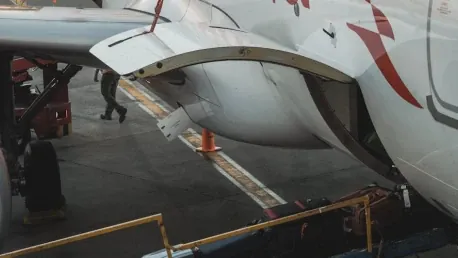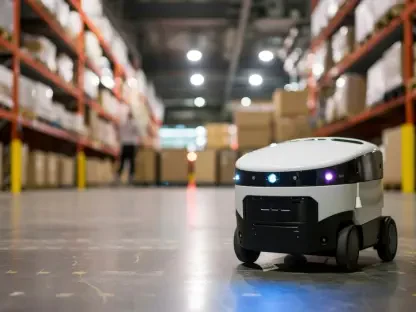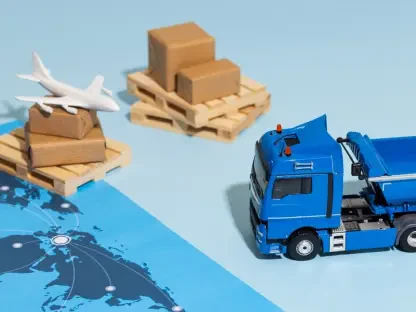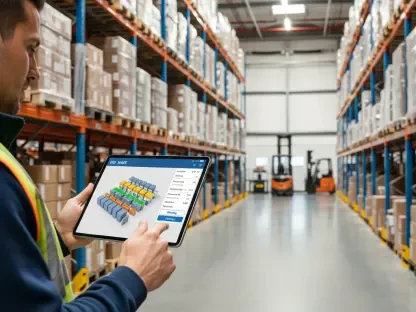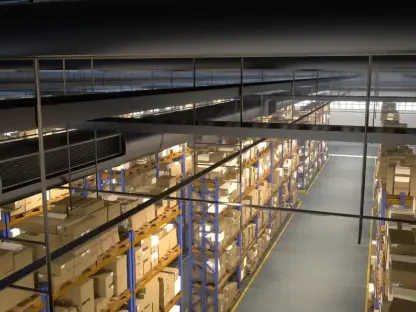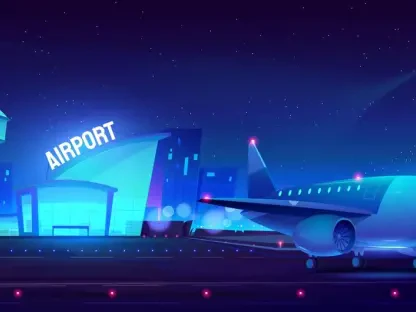The air cargo industry is undergoing a significant transformation as it grapples with increasing demand and the urgent need for sustainability. By 2025, the sector is expected to see a 4% to 5% growth in capacity, while demand could rise by 6% to 10%, depending on the trade lane. This gap between capacity and demand highlights the critical importance of innovation and sustainability within the industry. Thomas Kempf, Senior Director of Global Air Freight at Flexport, emphasizes the substantial changes aimed at creating a more eco-friendly industry.
Proactive Measures Towards Sustainability
Repurposing and Recycling Initiatives
A commendable number of stakeholders in the air cargo industry are taking proactive measures towards sustainability. Companies like Hong Kong Air Cargo Terminals Limited (Hactl) are repurposing old uniforms into reusable items like cups. High-profile carriers, including Lufthansa Cargo and ANA Cargo, have integrated AeroSHARK technology, which diminishes aircraft frictional resistance by approximately 1%, thus reducing fuel consumption. Not only do these efforts reduce environmental impact, but they also demonstrate the industry’s commitment to innovative solutions.
Airports have started to deploy electric dollies and tow trucks, reducing the reliance on fossil fuels. This shift towards electric ground support equipment is essential for minimizing greenhouse gas emissions and contributing to a more sustainable air cargo sector. Furthermore, these measures, alongside repurposing and recycling initiatives, represent a collective effort within the industry to embrace environmental responsibility. This holistic approach towards sustainability is paving the way for other stakeholders to adopt similar practices, strengthening the overall impact of these initiatives.
Adoption of Sustainable Aviation Fuel (SAF)
A pivotal element of the industry’s sustainability shift is the adoption of Sustainable Aviation Fuel (SAF). Major airlines such as Cathay Cargo, IAG Cargo, and Air France-KLM have committed to replacing at least 10% of their conventional fuel with SAF by 2030. Rajesh Menon, Cathay Cargo’s Regional Head of Cargo for South Asia, Middle East, and Africa, emphasizes the necessity of a multi-pronged approach to reduce emissions and transition towards low-carbon travel, targeting a 10% use of SAF for Cathay Pacific’s operational jet fuel by 2030. SAF can potentially reduce CO2 emissions by up to 80%, making it a promising option for decarbonization.
Airlines are not only focusing on incorporating SAF but are also investing in research and partnerships to accelerate its development and availability. This dedication to sustainable practices is crucial for achieving long-term environmental goals. By diversifying fuel sources and committing to SAF adoption, the industry aims to significantly reduce its carbon footprint, despite the challenges posed by higher costs and limited availability. Collaboration between governments, airlines, and fuel producers will be essential to overcome these obstacles and ensure the widespread adoption of SAF.
Global Sustainability Initiatives
European Union’s ReFuelEU Aviation Initiative
Various sustainability-focused initiatives are being launched worldwide. The European Union’s ReFuelEU Aviation initiative aspires for 2% SAF usage in aviation by 2025. This initiative is part of a broader effort to reduce the aviation industry’s carbon footprint and promote the use of sustainable fuels. By setting ambitious targets and providing regulatory support, the initiative aims to accelerate the transition towards more eco-friendly aviation practices.
The ReFuelEU Aviation initiative also encourages the development of a robust supply chain for SAF, ensuring that production and distribution capacities meet the growing demand. This holistic approach to sustainability encompasses technological advancements, regulatory frameworks, and industry collaboration. By fostering a supportive environment for SAF adoption, the European Union is positioning itself as a leader in sustainable aviation, setting an example for other regions to follow.
U.S. Government-Led SAF Grand Challenge
Stateside, the U.S. government-led SAF Grand Challenge, established in 2021, aims to scale up domestic SAF production significantly—from 3 billion gallons annually by 2030 to 35 billion by 2050. This ambitious goal is designed to curtail the aviation industry’s CO2 footprint and promote the widespread adoption of sustainable fuels. The SAF Grand Challenge encompasses a comprehensive strategy, involving public and private sector collaboration to enhance research, development, and commercialization of SAF.
The initiative also includes incentives for producers and users of SAF, fostering a favorable economic environment for its adoption. By addressing the challenges of high production costs and limited availability, the SAF Grand Challenge aims to make sustainable aviation a viable reality. The success of this initiative could serve as a catalyst for other countries to develop similar programs, furthering the global effort to reduce aviation-related carbon emissions.
Innovations in ULD and Pallet Manufacturing
Lightweight Materials and Durability
In ULD (Unit Load Device) and pallet manufacturing, significant innovation is creating new opportunities for sustainability. Lightweight materials, including recycled carbon fiber composites and bio-based polymers, are drastically reducing the fuel required for transportation due to their lighter weight while offering enhanced durability. These advanced materials are not only environmentally friendly but also cost-effective, as they contribute to lower fuel consumption and reduced operating expenses.
The ULD Climate Impact Label is being introduced to measure ULDs on their weight, spare part availability, and potential for reuse. This label provides transparency and encourages manufacturers to prioritize sustainability in their designs. By adopting lightweight and durable materials, the industry can significantly reduce its carbon footprint while maintaining high standards of performance and reliability. This innovative approach to ULD and pallet manufacturing is a crucial step towards achieving long-term sustainability goals.
Commitment from Original Equipment Manufacturers (OEMs)
Several leading Original Equipment Manufacturers (OEMs) are committed to this initiative, solidifying a significant step towards transparency and sustainability in ULD design and utilization. This commitment is crucial for driving industry-wide adoption of sustainable practices and materials. By collaborating with other stakeholders, OEMs are helping to create a more sustainable supply chain, from raw material sourcing to end-of-life recycling.
These collaborative efforts are essential for fostering a culture of sustainability within the air cargo industry. By setting high standards and demonstrating leadership, OEMs are encouraging other companies to follow suit. This collective approach ensures that sustainability becomes an integral part of the industry’s operations, ultimately leading to a more eco-friendly and resilient air cargo sector.
The Rise of eVTOL Aircraft
Urban Air Logistics and Last-Mile Delivery
Electric Vertical Take-Off and Landing (eVTOL) aircraft are poised to revolutionize urban air logistics and last-mile delivery operations. These aircraft combine the vertical take-off capabilities of helicopters with electric propulsion’s sustainability and efficiency, promising zero direct emissions and reduced noise levels. The versatility and environmentally friendly nature of eVTOLs make them ideal for addressing the growing demand for rapid and efficient urban logistics solutions.
The development of eVTOLs is supported by significant investments in research and innovation. Companies such as Beta Technologies are at the forefront, pioneering advancements that could reshape urban air transportation. By focusing on sustainability and operational efficiency, eVTOLs offer a promising solution to the challenges posed by traditional air cargo operations, paving the way for a cleaner and more efficient urban logistics ecosystem.
Development and Real-World Trials
Companies like Beta Technologies are at the forefront, developing eVTOLs such as the ALIA A250 and ALIA CX300, designed for dual-use in both cargo and passenger operations with significant cargo capacities and operational ranges. These aircraft are undergoing rigorous testing and real-world trials to ensure their safety, reliability, and performance. Successful trials and demonstrations are critical for gaining regulatory approval and public acceptance of eVTOL technology.
Additionally, VoloDrone is devising solutions specifically for cargo operations, demonstrating the viability of these aircraft through successful real-world trials. These trials have shown that eVTOLs can effectively meet the demands of last-mile delivery, offering a sustainable alternative to traditional logistics methods. As eVTOL technology continues to evolve, it holds the potential to transform urban cargo operations and contribute to a more sustainable future for the air cargo industry.
Transformation of Air Cargo Terminals
Integration of Advanced Technologies
Air cargo terminals are experiencing a transformation to align with sustainability goals. Contemporary cargo terminals are integrating advanced technologies and eco-friendly design principles. Solar panels, advanced building management systems, and energy-efficient equipment are commonplace in these modern facilities. These innovations contribute to reducing the environmental impact of cargo terminal operations and promote sustainable practices within the industry.
The implementation of advanced technologies is not limited to energy efficiency; it also encompasses automation and digitalization. Automated systems for sorting, tracking, and managing cargo help streamline operations, reduce errors, and enhance overall efficiency. These technological advancements enable cargo terminals to operate more sustainably and cost-effectively, aligning with the broader industry goals of reducing carbon emissions and minimizing environmental footprints.
Circular Processes and Certifications
The Cathay Cargo Terminal, for example, focuses on circular processes, recycling plastic sheets from import cargo shipments and reusing the recycled materials as cover sheets. This terminal is also among the first in Asia to attain the IATA Environmental Assessment (IEnvA) certification, evidencing its commitment to environmental stewardship. The implementation of circular processes reduces waste and promotes the efficient use of resources, contributing to the overall sustainability of cargo terminal operations.
Achieving certifications such as IEnvA demonstrates a terminal’s adherence to high environmental standards and underscores its dedication to sustainability. These certifications serve as benchmarks for other facilities, encouraging them to adopt similar practices and strive for excellence in environmental performance. By leading the way in sustainability, cargo terminals like the Cathay Cargo Terminal set a positive example for the entire industry, driving progress towards a greener and more responsible future.
Challenges and Collaborative Efforts
High Cost and Limited Availability of SAF
Despite the advances, challenges remain. The primary obstacle is the high cost and limited availability of SAF, which hinders large-scale adoption. The market premium for HEFA SAF in Europe in 2024 hovered around $1,000 per ton, significantly impacting the affordability and feasibility of widespread usage. Menon of Cathay Cargo asserts that increased governmental support is vital to incentivize SAF production and usage, requiring robust infrastructure for SAF transport and blending. Addressing these challenges is crucial for achieving the industry’s long-term sustainability goals.
Additionally, significant investment is necessary for developing sustainable operational infrastructure, balancing immediate needs with sustainability goals. Investments in research, development, and production capacities for SAF are essential to reduce costs and increase availability. Governmental policies and incentives can play a pivotal role in driving these investments, encouraging industry players to adopt sustainable practices despite the financial challenges.
Collaboration Across the Supply Chain
The air cargo industry is experiencing a major transformation as it contends with rising demand and a pressing need for sustainability. By 2025, it’s anticipated that the sector will achieve a 4% to 5% growth in capacity. However, demand could jump by 6% to 10%, depending on specific trade routes. This discrepancy between capacity and demand highlights the urgent necessity for innovation and sustainability within the industry.
According to Thomas Kempf, Senior Director of Global Air Freight at Flexport, there are significant efforts underway to make the industry more environmentally friendly. These changes are essential for the future of air cargo, as the sector cannot continue to grow at the expense of the environment. Methods such as adopting more efficient aircraft, optimizing routes, and investing in sustainable fuel options are all being explored to bridge this gap.
In addition to environmental efforts, the air cargo industry is also focusing on digitalization and modernization. Implementing advanced technologies and data analytics will help improve efficiency, reduce carbon emissions, and meet the increasing demand. Collaboration between stakeholders, including airlines, shippers, and governments, is crucial in achieving sustainable growth.
The future of air cargo hinges on balancing growth with sustainability. By embracing innovation, improving operational efficiency, and investing in green technologies, the industry aims to meet rising demand while minimizing its environmental impact.
